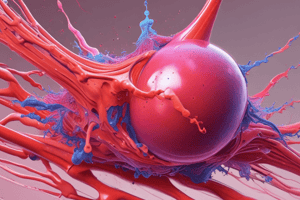Podcast
Questions and Answers
What is the primary location for fluid exchange between plasma and interstitial fluid?
What is the primary location for fluid exchange between plasma and interstitial fluid?
Capillaries
Which of the following are Starling's forces involved in fluid exchange?
Which of the following are Starling's forces involved in fluid exchange?
- Interstitial oncotic pressure (correct)
- Interstitial hydrostatic pressure (correct)
- Capillary oncotic pressure (correct)
- Capillary hydrostatic pressure (correct)
Capillary hydrostatic pressure favors the absorption of fluid into the capillaries.
Capillary hydrostatic pressure favors the absorption of fluid into the capillaries.
False (B)
Capillary oncotic pressure (πC) favors the movement of fluid from the interstitium to the capillaries.
Capillary oncotic pressure (πC) favors the movement of fluid from the interstitium to the capillaries.
What is the formula for calculating the net filtration pressure (NFP)?
What is the formula for calculating the net filtration pressure (NFP)?
At the arterial end of the capillary, net filtration pressure is typically positive (greater than zero), making the movement of fluid from the capillaries into the interstitial space dominant.
At the arterial end of the capillary, net filtration pressure is typically positive (greater than zero), making the movement of fluid from the capillaries into the interstitial space dominant.
At the venular end of the capillary, net filtration pressure is typically negative (less than zero), making the movement of fluid from the interstitial space into the capillaries dominant.
At the venular end of the capillary, net filtration pressure is typically negative (less than zero), making the movement of fluid from the interstitial space into the capillaries dominant.
Approximately what percentage of filtered fluid is reabsorbed back into the capillaries at the venous end?
Approximately what percentage of filtered fluid is reabsorbed back into the capillaries at the venous end?
What is the main function of the lymphatic system in regard to fluid exchange?
What is the main function of the lymphatic system in regard to fluid exchange?
What is edema?
What is edema?
Which of the following factors can contribute to edema?
Which of the following factors can contribute to edema?
Which conditions can lead to high capillary hydrostatic pressure?
Which conditions can lead to high capillary hydrostatic pressure?
Which conditions can lead to low capillary oncotic pressure?
Which conditions can lead to low capillary oncotic pressure?
Which conditions can lead to lymphatic obstruction?
Which conditions can lead to lymphatic obstruction?
Which conditions can lead to increased permeability of capillaries to proteins?
Which conditions can lead to increased permeability of capillaries to proteins?
Which of the following are types of edema based on the nature of the fluid accumulation?
Which of the following are types of edema based on the nature of the fluid accumulation?
Which of the following conditions can lead to pitting edema?
Which of the following conditions can lead to pitting edema?
Which of the following are types of edema based on the distribution of fluid accumulation?
Which of the following are types of edema based on the distribution of fluid accumulation?
Which of the following conditions can lead to generalized edema?
Which of the following conditions can lead to generalized edema?
Flashcards
Fluid Exchange
Fluid Exchange
The movement of fluid between the blood plasma and the interstitial fluid, primarily occurring at the capillaries.
Hydrostatic Pressure
Hydrostatic Pressure
The pressure exerted by the fluid within a blood vessel against its walls.
Oncotic Pressure
Oncotic Pressure
The osmotic pressure created by proteins in a solution, primarily albumin, drawing fluid towards the area of higher protein concentration.
Filtration
Filtration
Signup and view all the flashcards
Absorption
Absorption
Signup and view all the flashcards
Net Filtration Pressure (NFP)
Net Filtration Pressure (NFP)
Signup and view all the flashcards
Interstitial Fluid Hydrostatic Pressure (HPISF)
Interstitial Fluid Hydrostatic Pressure (HPISF)
Signup and view all the flashcards
Interstitial Fluid Oncotic Pressure (πISF)
Interstitial Fluid Oncotic Pressure (πISF)
Signup and view all the flashcards
Arteriolar End of Capillaries
Arteriolar End of Capillaries
Signup and view all the flashcards
Veniolar End of Capillaries
Veniolar End of Capillaries
Signup and view all the flashcards
Lymphatic Vessels
Lymphatic Vessels
Signup and view all the flashcards
Edema
Edema
Signup and view all the flashcards
High HPc
High HPc
Signup and view all the flashcards
Low OPc
Low OPc
Signup and view all the flashcards
Lymphatic Obstruction
Lymphatic Obstruction
Signup and view all the flashcards
Increased Permeability
Increased Permeability
Signup and view all the flashcards
Pitting Edema
Pitting Edema
Signup and view all the flashcards
Non-pitting Edema
Non-pitting Edema
Signup and view all the flashcards
Generalized Edema
Generalized Edema
Signup and view all the flashcards
Localized Edema
Localized Edema
Signup and view all the flashcards
Congestive Heart Failure
Congestive Heart Failure
Signup and view all the flashcards
Deep Vein Thrombosis
Deep Vein Thrombosis
Signup and view all the flashcards
Filariasis (Elephantiasis)
Filariasis (Elephantiasis)
Signup and view all the flashcards
Chronic Liver Disease
Chronic Liver Disease
Signup and view all the flashcards
Chronic Renal Disease (Nephrotic Syndrome)
Chronic Renal Disease (Nephrotic Syndrome)
Signup and view all the flashcards
Allergy or Inflammation
Allergy or Inflammation
Signup and view all the flashcards
Burns
Burns
Signup and view all the flashcards
Tumors
Tumors
Signup and view all the flashcards
Surgical Removal of Lymphatic System
Surgical Removal of Lymphatic System
Signup and view all the flashcards
Study Notes
Fluid Exchange and Edema
- Fluid exchange occurs at capillaries, driven by Starling forces.
- Starling forces include hydrostatic pressure (water pressure) and oncotic pressure (protein pressure).
- Hydrostatic pressure pushes fluid out of capillaries into interstitial fluid.
- Oncotic pressure pulls fluid back into capillaries.
- At the arterial end of capillaries, hydrostatic pressure is higher than oncotic pressure, resulting in filtration of fluid.
- At the venous end of capillaries, oncotic pressure is higher than hydrostatic pressure, resulting in absorption of fluid.
- The remaining 10% of filtered fluid is absorbed by lymphatic vessels.
- Edema is abnormal fluid collection in the interstitial fluid, with pitting and non-pitting types.
Mechanisms of Edema
- High hydrostatic pressure (HPc) can cause edema; this is caused by heart failure or venous obstruction.
- Low oncotic pressure (OPc) can cause edema; this is caused by malnutrition, malabsorption, Chronic liver disease or Chronic renal disease (nephrotic syndrome).
- Lymphatic obstruction, tumors or surgical removal can also lead to edema.
- Allergy, inflammation or burns can also lead to increased edema through increased capillary permeability.
Types of Edema
- Edema can be classified as pitting or non-pitting.
- Pitting edema is caused by high hydrostatic pressure and low oncotic pressure, and affects multiple areas of the body (generalized).
- Non-pitting edema is caused by lymphatic obstruction, increased capillary permeability or localized causes, and is often localized.
- Generalized edema can result from low capillary oncotic pressure, such as Congestive Heart Failure.
- Localized edema is often associated with lymphatic obstruction, venous obstruction or causes of increased permeability.
Studying That Suits You
Use AI to generate personalized quizzes and flashcards to suit your learning preferences.




